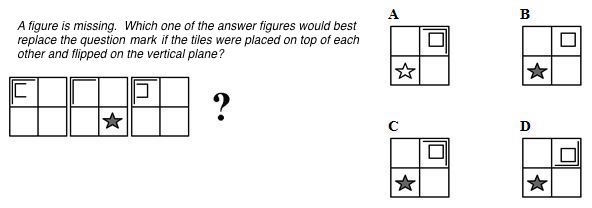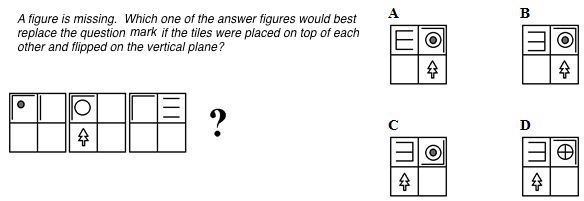14. Stacks
‘Stacks’ is a type of abstract reasoning question that extends upon flips by testing whether you can see how ‘order’ is modified with a flip of layers.
Like flips, there is:
- an invisible axis (this can be vertical, horizontal or at various angles).
- original image. But in stacks, this original image is often composed of layers.
And once flipped, you get the:
- mirror image / reflection / or flipped layers.
Remember, here are the rules for flips:
- If the image is flipped horizontally (on a vertical axis), what is left in the original image is then on the right in the mirror image, and vice versa (see image “Horizontal Flip”).
- If the image is flipped vertically (on a horizontal axis), what is at the top in the original image is then on the bottom in the mirror image, and vice versa (see image “Vertical Flip”).
What you should note is that in the flipped stack:
- The original bottom layer is now at the top and is the most visible. This means that if your bottom layer is opaque, then you won’t see anything else (layers beneath).
- The original top layer is now at the bottom and is the least visible.
So, really in stacks. The rules for a general flip still apply, but the only added dimension is:
- What’s visible and what’s not visible depending on the ordering of the layers.
Let’s look at the image below to see the additional steps to solve these types of problem in an abstract reasoning test.

Now that you know the rules and because abstract reasoning involves visual pattern detection, let’s apply this to the following question/s.
Example Question/s
Watch video for explanation of the following question/s:


Key Rules to remember
- In stacks, if a stack is flipped, you’ll inherit the rules from flips (see previous checkpoint). Then you’ll also need to do a secondary step and organise the layers based on visibility. Being:
- The original bottom layer is now at the top and is the most visible. This means that if your bottom layer is opaque, then you won’t see anything else (layers beneath).
- The original top layer is now at the bottom and is the least visible.
Practice time!
Now, it's your turn to practice.
Click on the button below and start your practice questions. We recommend doing untimed mode first, and then, when you're ready, do timed mode.
Every question has two solutions videos after you complete the question. The first is a quick 60 second video that shows you how our expert answers the question quickly. The second video is a more in-depth 5-steps or less explainer video that shows you the steps to take to answer the question. It's really important that you review the second video because that's where you'll learn additional tips and tricks.
Once you're done with the practice questions, move on to the next checkpoint.
Now, let’s get started on your practice questions.
10 questions
Take a Timed Test Take an Untimed Test